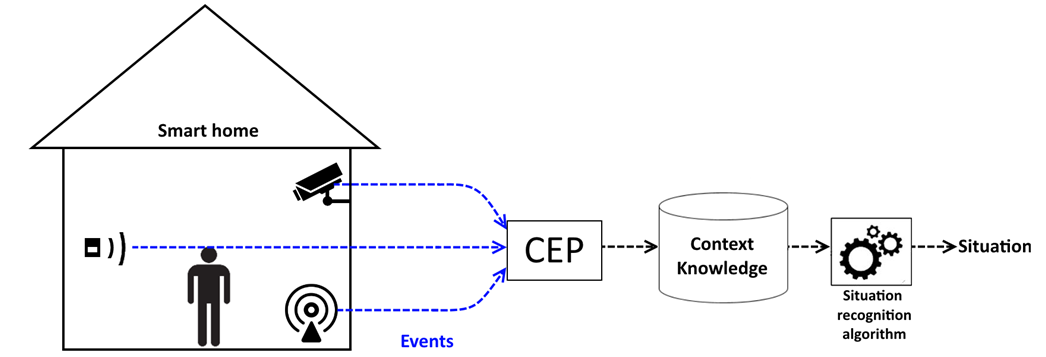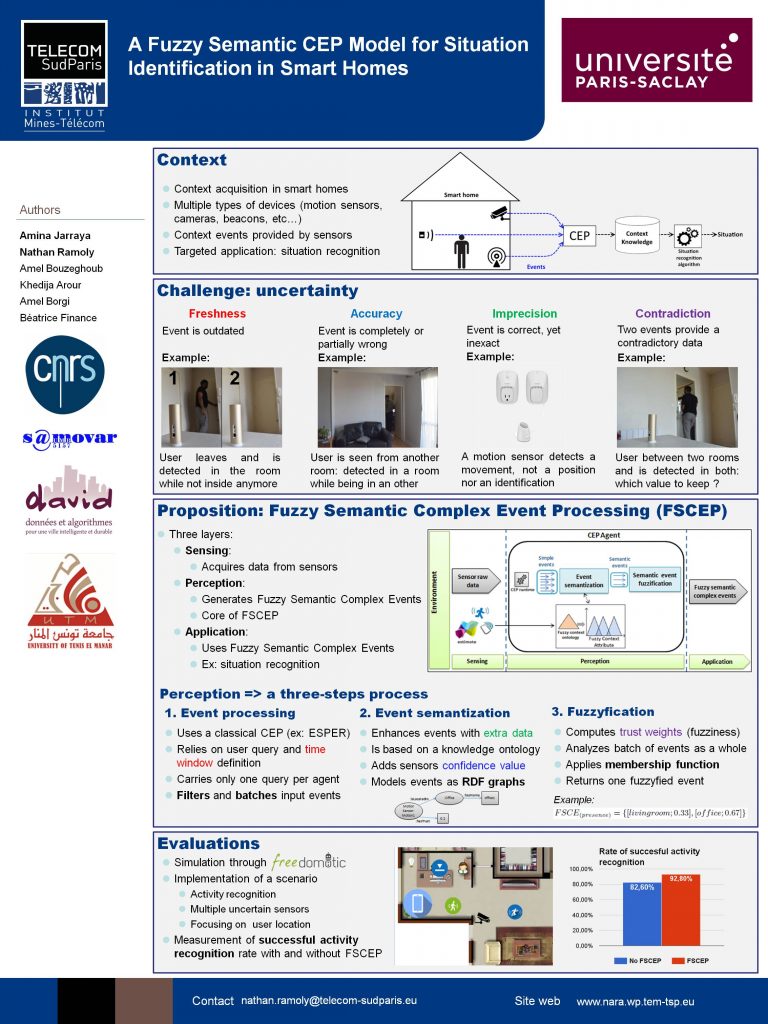Fuzzy Semantic Complex Event Processing (FSCEP) is an improvement of CEPs for uncertain context acquisition in smart homes. The aim of this work is to tackle uncertain data acquired in smart home by processing and enhancing events. As the name implies, it uses a semantic model and fuzzy logic.
Introduction
Our work positions itself in the context acquisition. The context is then used for other applications, such as situation recognition. We supposed the smart environment provides events about what’s happening around. Note that we consider all sensors on the same level, both pushing and pulling sensors: pushing sensors provide events ‘naturally’ while pulling sensors are periodically queried and processed to generate events. Events are gathered and analysed through a CEP (such as ESPER) before being stored in a context knowledge. Our work consists in improving the CEP.
Challenge
In smart homes applications, it is to expect that sensors will not provide perfect data. In fact, provided data can be uncertain on multiple dimensions. We identify four dimension we could encounter and we aim to tackle:
- Freshness: The data is outdated. Typically, a sensor decteted something some times ago which not valid anymore. For example, a user can be detected in a room right before leaving it.
- Accuracy: The data is wrong or partially wrong. In other word, the sensor made a mistake. For example, a vision algorithm can fail to detect some one.
- Imprecision: The data is true, yet inexact. For example, the user may be known at home thanks to a motion sensors, but is not precisely localised inside.
- Contradiction: Two sensors (or more) provide a contradictory data: for instance the user can be detected in two rooms at the same time…
What we did
We improved a CEP in order to provide not only complex event, but fuzzy semantic complex events (FSCE). With these new properties, events carry information to tackle uncertainty. Our approach uses as input the raw events from the sensors (a small layer of processing is however required to format them into the used CEP format) and provide as output FSCEs that will feed a context ontology.
FSCEP is a three steps process:
- Events acquisition: Raw events are gathered, formatted and processed by a classic CEP. This CEP will filter and batch the events in time-window according to a user defined query.
- Semantization: Events (in batches) are enhanced using a semantic (ontological) background knowledge. These enhancements includes information about sensors and data (position, trust, type, target, etc…). The events are also formatted into RDF format that respect the structure of the output context ontology (using the T-box of this ontology).
- Fuzzyfication: A batch of semantic events is analyzed as a whole to compute one FSCE. A dedicated membership is defined ans uses the properties of events to compute the fuzzy trust weights.
For more information…
- Amina Jarraya, Nathan Ramoly, Amel Bouzeghoub, Khedija Arour, Amel Borgi, Béatrice Finance, “A Fuzzy Semantic CEP Model for Situation Identification in Smart Homes”, European Conference on Artificial Intelligence, 2016
- Amina Jarraya, Nathan Ramoly, Amel Bouzeghoub, Khedija Arour, Amel Borgi, Béatrice Finance, “FSCEP: a new model for Context Perception in Smart Homes”, International Conference on Cooperative Information Systems, 2016
Or ask me. ;)



